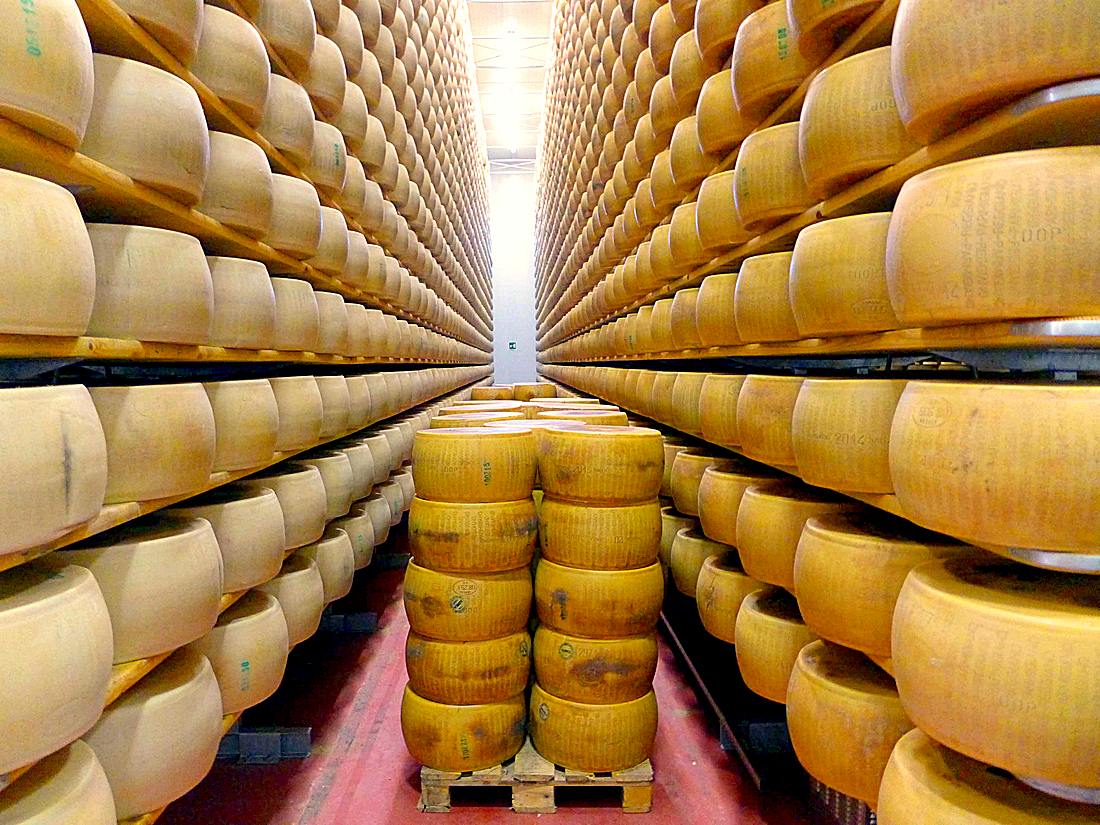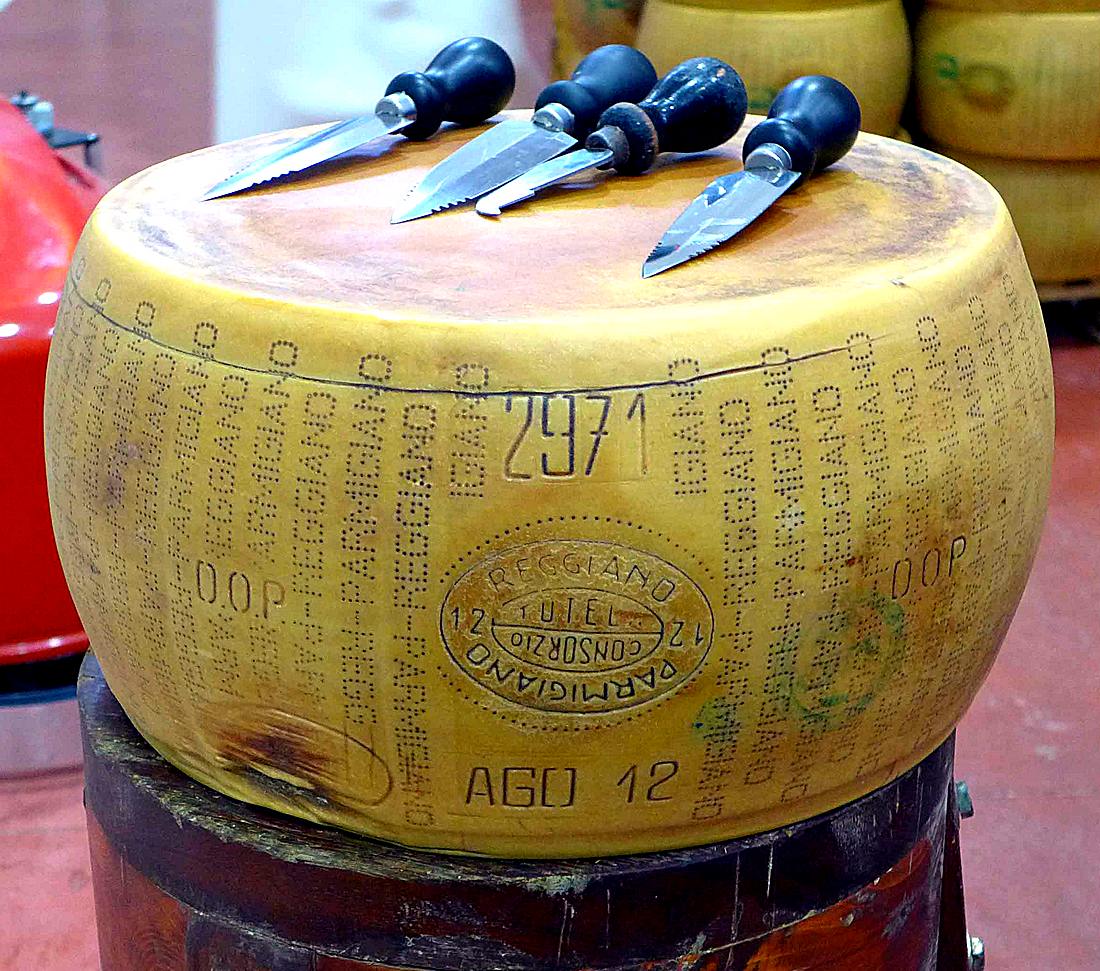
The king of Italian cheeses is Parmigiano Reggiano, which is head and shoulders above the various imitators sold as “parmesan” in the U.S. and Canada.
 I had always wondered why the D.O.P. product was so clearly superior, and a visit to Caseificio Poggioli (+39 059 783 155, http://poggiolicoopcasearia.it/en/) on the Via Montanara in Spilimberto outside Modena helped me understand. The new €6 million facility is a cooperative of four dairy farmers of Modena province and was built, partly with public financing, after the May 2012 earthquake that destroyed so many of the region’s cheese factories and aging warehouses. Yet to be tested by seismic events, the facility is equipped with state-of-the-art controls for the time-honored process of making Parmigiano Reggiano.
I had always wondered why the D.O.P. product was so clearly superior, and a visit to Caseificio Poggioli (+39 059 783 155, http://poggiolicoopcasearia.it/en/) on the Via Montanara in Spilimberto outside Modena helped me understand. The new €6 million facility is a cooperative of four dairy farmers of Modena province and was built, partly with public financing, after the May 2012 earthquake that destroyed so many of the region’s cheese factories and aging warehouses. Yet to be tested by seismic events, the facility is equipped with state-of-the-art controls for the time-honored process of making Parmigiano Reggiano.
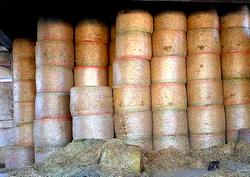 Under the D.O.P. regulations, all the milk must come from herds within a prescribed geographic area in the provinces of Parma, Reggio Emilia, Modena, and Mantua on the right bank of the Po river, and Bologna on the left bank of the Reno river. The rolling plains between the rivers are covered in rich grasslands, and all the feed for the cattle, both green pasturage and stored hay, must also come from the region. The cattle are not allowed to eat silage because—unlike most other Italian grating cheeses, such as Grana Padano—Parmigiano Reggiano is not pasteurized.
Under the D.O.P. regulations, all the milk must come from herds within a prescribed geographic area in the provinces of Parma, Reggio Emilia, Modena, and Mantua on the right bank of the Po river, and Bologna on the left bank of the Reno river. The rolling plains between the rivers are covered in rich grasslands, and all the feed for the cattle, both green pasturage and stored hay, must also come from the region. The cattle are not allowed to eat silage because—unlike most other Italian grating cheeses, such as Grana Padano—Parmigiano Reggiano is not pasteurized.
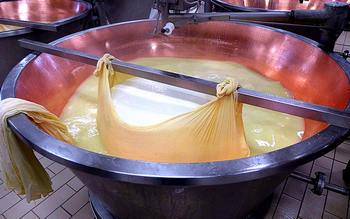 In many ways, the cheese production proceeds as it always has. Milk from the evening milking is placed in shallow steel trays overnight and is partially skimmed in the morning before being placed into copper-lined cauldrons with an inverted bell shape. It is topped with whole milk from the morning milking to bring the volume up to 1,100 liters. Rennet is added and the mixture is heated to promote coagulation of the proteins. The new equipment at Poggioli stirs the curd, allowing the factory to make a lot of cheese with very few cheesemakers. When the cheese reaches a texture determined by the cheesemaker, he or she will cut the curd in half. Each piece will be cradled in a linen cloth and lifted from the whey.
In many ways, the cheese production proceeds as it always has. Milk from the evening milking is placed in shallow steel trays overnight and is partially skimmed in the morning before being placed into copper-lined cauldrons with an inverted bell shape. It is topped with whole milk from the morning milking to bring the volume up to 1,100 liters. Rennet is added and the mixture is heated to promote coagulation of the proteins. The new equipment at Poggioli stirs the curd, allowing the factory to make a lot of cheese with very few cheesemakers. When the cheese reaches a texture determined by the cheesemaker, he or she will cut the curd in half. Each piece will be cradled in a linen cloth and lifted from the whey.
 The bulbous masses go on a line to drain and be transported to another room, where each one is lifted into a plastic form. Each form has a band that imprints the place and date and numbers each wheel separately. After sitting in a seawater bath for about three weeks, the wheels are cleaned and dried and placed on wooden shelves to begin aging.
The bulbous masses go on a line to drain and be transported to another room, where each one is lifted into a plastic form. Each form has a band that imprints the place and date and numbers each wheel separately. After sitting in a seawater bath for about three weeks, the wheels are cleaned and dried and placed on wooden shelves to begin aging.
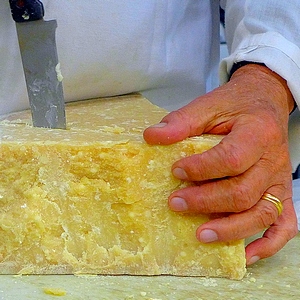 By regulation the cheese must age for at least 12 months. In practice, Parmigiano Reggiano is rarely sold until it is at least 24-30 months old. At that stage, the cheese begins to develop protein crystals that give it a slight crunch. As it continues to age, the umami flavor becomes ever more pronounced. At 36 months, most wheels begin their decline as they become too dry.
By regulation the cheese must age for at least 12 months. In practice, Parmigiano Reggiano is rarely sold until it is at least 24-30 months old. At that stage, the cheese begins to develop protein crystals that give it a slight crunch. As it continues to age, the umami flavor becomes ever more pronounced. At 36 months, most wheels begin their decline as they become too dry.
From just four farms, Poggioli makes 18,000 wheels of cheese per year, which is a lot of sprinkles on top of pasta. The aging rooms contain more than 50,000 wheels at a time. The photo below shows just one row of one room of the warehouse. When the last earthquake hit, wheels went flying off the shelves. If another big one strikes, they should stay put, thanks to giant shock absorbers.
The cheeses from Poggioli are exquisite. You can buy them by the piece at the factory in sizes from half-kilo chunks to entire wheels. It’s also available at the public market in Modena.

